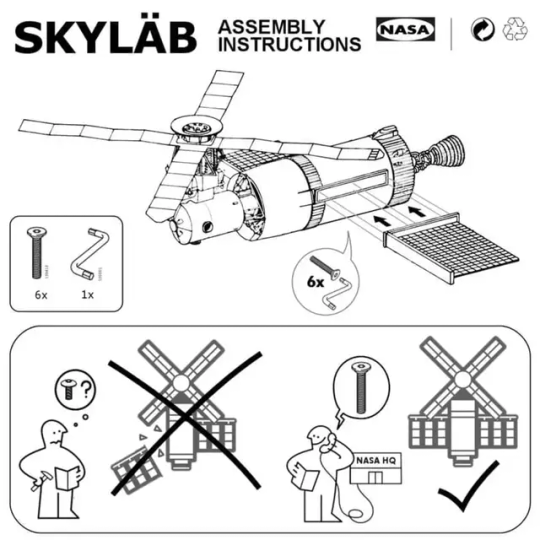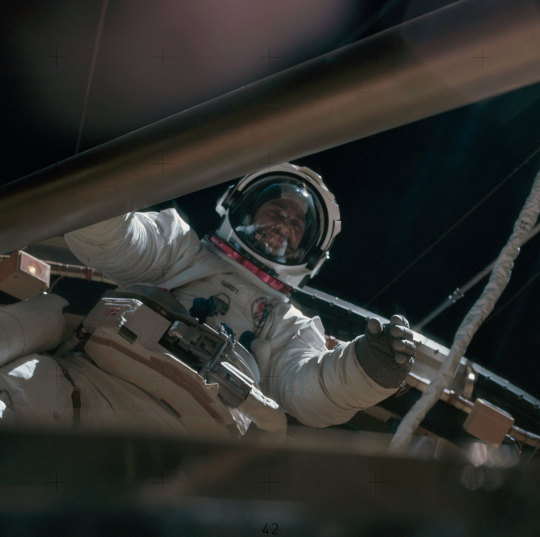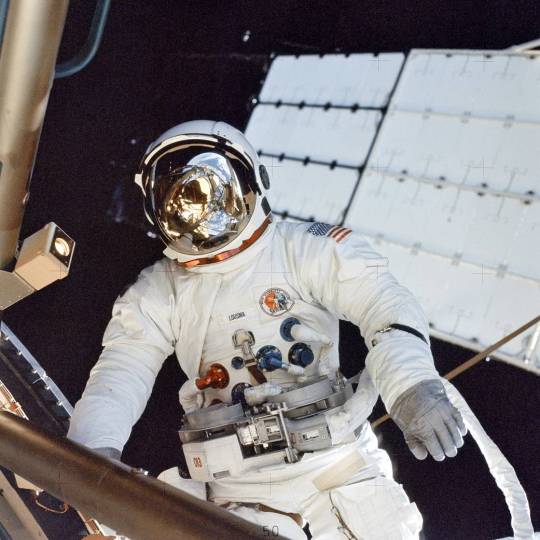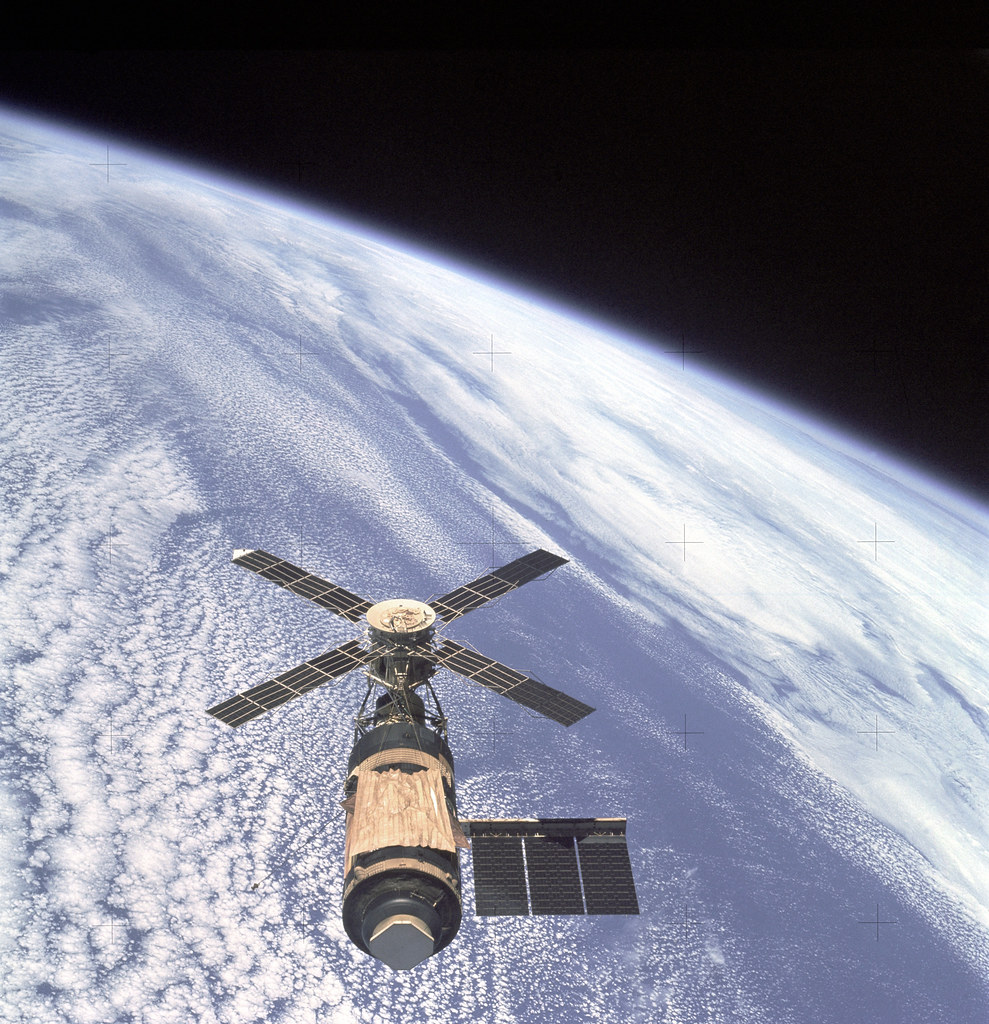#Skylab Orbital Workshop
Text

source
#Skylab Orbital Workshop#Skylab OWS#Skylab#Skylab I#Skylab 1#SL-1#Space Station#Apollo Telescope Mount#ATM#NASA#Apollo Program#Apollo Applications Program#IKEA#meme#my post
130 notes
·
View notes
Text
Behold—the space station of the future! (…from 1973)

This artist’s concept gives a cutaway view of the Skylab orbital workshop, which launched 50 years ago on May 14, 1973. Established in 1970, the Skylab Program's goals were to enrich our scientific knowledge of Earth, the sun, the stars, and cosmic space; to study the effects of weightlessness on living organisms; to study the effects of the processing and manufacturing of materials in the absence of gravity; and to conduct Earth-resource observations.
Three crews visited Skylab and carried out 270 scientific and technical investigations in the fields of physics, astronomy, and biological sciences. They also proved that humans could live and work in outer space for extended periods of time, laying the groundwork for the International Space Station.
Make sure to follow us on Tumblr for your regular dose of space!
2K notes
·
View notes
Text
En l'an mil neuf cent quatre-vingt-treize
Di lo que sabes sobre el año en el que naciste.
An overhead view of the Skylab Orbital Workshop in Earth orbit as photographed from the Skylab 4 Command and Service Modules (CSM) during the final fly-around by the CSM before returning home. The space station is contrasted against the pale blue Earth. During launch on May 14, 1973, some 63 seconds into flight, the micrometeor shield on the…

View On WordPress
0 notes
Text
En l'an mil neuf cent quatre-vingt-treize
Di lo que sabes sobre el año en el que naciste.
An overhead view of the Skylab Orbital Workshop in Earth orbit as photographed from the Skylab 4 Command and Service Modules (CSM) during the final fly-around by the CSM before returning home. The space station is contrasted against the pale blue Earth. During launch on May 14, 1973, some 63 seconds into flight, the micrometeor shield on the…

View On WordPress
0 notes
Link
A 35mm camera, operated by astronaut William R. Pogue, Skylab 4 pilot, recorded this wide scene of his Skylab 4 crewmates on the other end of the orbital workshop. Astronauts Jerry P. Carr (right), commander, and Edward G. Gibson, science pilot, pose for the snapshot. Also in the frame are parts of three Extravehicular Mobility Unit (EMU) spacesuits, used on several EVA sessions during the third manning of the Skylab space station.
0 notes
Text
A View Through Skylab
Astronaut William R. Pogue, Skylab 4 pilot, recorded this wide scene of his crewmates, astronauts Edward G. Gibson (left), science pilot, and Jerry P. Carr (right), commander, on the other end of the orbital workshop on Feb. 1, 1974. Also in the frame are parts of three spacesuits, used on several EVA sessions during the […]
from NASA https://ift.tt/GyFO2g4
0 notes
Text
Space history for Sunday.


On this day in 1973, Skylab III astronauts Owen K. Garriott (top. Get a shave, dude!) and Jack R. Lousma deployed the "twin pole" solar shield to help shade the Orbital Workshop.

The solar shield built onto the workshop was torn off during launch and temperature inside the lab skyrocketed (if you will) to between 130°F to 150°F. The Skylab II crew installed the "parasol" sunshade that could be deployed from inside the spacecraft without an EVA. The "twin pole" shade augmented the "parasol" and brought temperatures down to the normal expected levels.
0 notes
Text
50 years earlier, Skylab introduced into orbit. See what it indicated to an astronaut on a spaceport station now.
50 years back, Skylab released into orbit. See what it suggested to an astronaut on a spaceport station now., Stephen Bowen keeps in mind seeing Skylab fly overhead. At 8 years of ages, Bowen’s experience sustained his interest in spaceflight. Little did he understand where that would take him 50 years later on …, 2023-05-14 12:29:00,
House
News
Human Spaceflights
The Skylab orbital workshop…

View On WordPress
0 notes
Text

Up, up & away! Alan Bean tests out the Astronaut Maneuvering Equipment in the dome area of the Orbital Workshop on Skylab 3, Aug 1973. The dome measured 19 feet in height & 23 feet in diameter. Bean commanded the 59-day mission to America’s first space station & flew the mission with Owen Garriott & Jack Lousma. There were 3 spacewalks during Skylab 3, totalling over 13 hours. It was the 2nd of 3 crewed flights to Skylab, an intriguing chapter in American space history following the final Apollo 17 moon landing.
#alan bean#skylab#astronaut#nasa#space age#space travel#space program#space history#astronauts#space#1973#skylab 3#spaceman#zero gravity#space exploration#space flight#1970s#space race#vintage space#outer space#space station#space explorer
51 notes
·
View notes
Text
Skylab and Space Shuttle Astronaut Owen Garriott Dies at 88
Rest In Peace.
April 16, 2019
Former astronaut and long-duration spaceflight pioneer Owen Garriott, 88, died today, April 15, at his home in Huntsville, Alabama. Garriott flew aboard the Skylab space station during the Skylab 3 mission and on the Space Shuttle Columbia for the STS-9/Spacelab-1 mission. He spent a total of 70 days in space.
Image above: Scientist-Astronaut Owen K. Garriott, science pilot of the Skylab 3 mission, is stationed at the Apollo Telescope Mount (ATM) console in the Multiple Docking Adapter of the Skylab space station in Earth orbit. From this console the astronauts actively control the ATM solar physics telescope. (sl3-108-1288). Image Credit: NASA.
“The astronauts, scientists and engineers at Johnson Space Center are saddened by the loss of Owen Garriott,” said Chief Astronaut Pat Forrester. “We remember the history he made during the Skylab and space shuttle programs that helped shape the space program we have today. Not only was he a bright scientist and astronaut, he and his crewmates set the stage for international cooperation in human spaceflight. He also was the first to participate in amateur radio from space, a hobby many of our astronauts still enjoy today.”
Garriott was born in Enid, Oklahoma. He earned a bachelor’s degree in electrical engineering from the University of Oklahoma, and master’s and doctoral degrees in electrical engineering from Stanford University, Palo Alto, California. Garriott served as an electronics officer while on active duty with the U.S. Navy from 1953 to 1956, and was stationed aboard several U.S. destroyers at sea. He then taught electronics, electromagnetic theory and ionospheric physics as an associate professor at Stanford. He performed research in ionospheric physics and has authored or co-authored more than 40 scientific papers and one book on this subject.
Image above: Hall of Fame astronaut Owen Garriott thanks the audience for their applause at the 2011 U.S. Astronaut Hall of Fame induction ceremony at NASA's Kennedy Space Center Visitor Complex in Florida. Image Credits: NASA/Jim Grossmann.
He was selected as a scientist-astronaut by NASA in June 1965, and then completed a 53-week course in flight training at Williams Air Force Base, Arizona. He logged more than 5,000 hours flying time -- including more than 2,900 hours in jet and light aircraft, spacecraft and helicopters. In addition to NASA ratings, he held FAA commercial pilot and flight instructor certification for instrument and multi-engine aircraft.
Garriott was the science-pilot for Skylab 3, the second crewed Skylab mission, and was in orbit from July 28 to Sept. 25, 1973. His crewmates were Commander Alan Bean and Pilot Jack Lousma. The crew accomplished 150% of mission goals while completing 858 revolutions of the Earth and traveling some 24.5 million miles. The crew installed replacement rate gyros used for attitude control of the spacecraft and a twin pole sunshade used for thermal control, and repaired nine major experiment or operational equipment items. They devoted 305 hours to extensive solar observations and completed 333 medical experiment performances to obtain valuable data on the effects of extended weightlessness on humans. The crew of Skylab 3 logged 1,427 hours and 9 minutes each in space, setting a world record for a single mission, and Garriott spent 13 hours and 43 minutes in three separate spacewalks outside the orbital workshop.
Image above: Scientist-astronaut Owen K. Garriott, Skylab 3 science pilot, participates in the Aug. 6, 1973 extravehicular activity during which he and astronaut Jack Lousma, Skylab 3 pilot, deployed the twin pole solar shield to help shade the Orbital Workshop. Image Credit: NASA.
On his second and final flight, Garriott flew as a mission specialist on the ninth space shuttle mission and the first six-person flight. He launched aboard the Space Shuttle Columbia for STS-9/Spacelab-1 from Kennedy Space Center, Florida, on Nov. 28, 1983. His crewmates were Commander John Young, Pilot Brewster Shaw, Jr., fellow mission specialist Robert Parker, and Payload Specialists Byron Lichtenberg and Ulf Merbold of (ESA) European Space Agency. This six-person crew was the largest yet to fly aboard a single spacecraft, the first international shuttle crew and the first to carry payload specialists. During STS-9, the first human amateur radio operations in space were conducted using Garriott's station call, W5LFL. After 10 days of Spacelab hardware verification and around-the-clock scientific operations, Columbia and its laboratory cargo landed on the dry lakebed at Edwards Air Force Base, California, on Dec. 8, 1983.
Garriott held other positions at Johnson Space Center such as deputy and later director of Science and Applications, and as the assistant director for Space and Life Science.
For Garriott’s official NASA biography, visit: https://www.nasa.gov/sites/default/files/atoms/files/garriott_owen.pdf
Related link:
Skylab: https://www.nasa.gov/mission_pages/skylab/
Images (mentioned), Text, Credits: NASA/Jason Townsend.
R.I.P., Orbiter.ch
Full article
44 notes
·
View notes
Photo

An overhead view of the Skylab Orbital Workshop in Earth orbit as photographed from the Skylab 4 Command and Service Modules (CSM) during the final fly-around by the CSM before returning home. - February 8, 1974 [3000 x 3106]
45 notes
·
View notes
Text

"In 1973, Skylab, America's first space station, was launched aboard a two-stage Saturn V vehicle. Saturn IB rockets were used to launch three different three-man crews to the Skylab space station."
Date: May 1, 1973
NASA ID: 7038484
#Skylab Orbital Workshop#Skylab OWS#Skylab#Skylab I#Skylab 1#SL-1#Space Station#Apollo Telescope Mount#ATM#Saturn V#Saturn INT-21#SA-513#Rocket#NASA#Apollo Program#Apollo Applications Program#LC-39A#Kennedy Space Center#Florida#May#1973#my post
245 notes
·
View notes
Photo

An overhead view of the Skylab Orbital Workshop in Earth orbit as photographed from the Skylab 4 Command and Service Modules (CSM) during the final fly-around by the CSM before returning home. - February 8, 1974 [3000 x 3106]
28 notes
·
View notes
Video
Skylab and Earth Limb by NASA on The Commons
Via Flickr:
An overhead view of the Skylab Orbital Workshop in Earth orbit as photographed from the Skylab 4 Command and Service Modules (CSM) during the final fly-around by the CSM before returning home. The space station is contrasted against the pale blue Earth. During launch on May 14, 1973, some 63 seconds into flight, the micrometeor shield on the Orbital Workshop (OWS) experienced a failure that caused it to be caught up in the supersonic air flow during ascent. This ripped the shield from the OWS and damaged the tie downs that secured one of the solar array systems. Complete loss of one of the solar arrays happened at 593 seconds when the exhaust plume from the S-II's separation rockets impacted the partially deployed solar array system. Without the micrometeoroid shield that was to protect against solar heating as well, temperatures inside the OWS rose to 126 degrees fahrenheit. The gold "parasol" clearly visible in the photo, was designed to replace the missing micrometeoroid shield, protecting the workshop against solar heating. The replacement solar shield was deployed by the Skylab I crew. This enabled the Skylab Orbital Workshop to fulfill all its mission objects serving as home to additional crews before being deorbited in 1978. Skylab fell back to Earth on July 11, 1979. Image # : SL4-143-4706 Date: February 8, 1974
#Apollo Command Service Module#Micrometeoroid#Parasol Solar Shield#S-II Solar Array#Skylab Orbital Workshop#Now Playing#8th#February#2017#February 8th 2017
0 notes
Photo

April 1973 Skylab 2 training procedures in the Skylab Orbital Workshop where astronaut Charles "Pete" Conrad sat on the human vestibular experiment as dynamic measurements were taken by flight surgeon/astronaut Joseph Kerwin. Note Pete Conrad was wearing his personal Gold Rolex Day-Date wrist watch.
(Photo: NASA)
#Rolex#Astronaut#NASA#Skylab#Navy#Diver#RolexDiver#RolexHistory#RolexSpace#RolexMagazine#RolexHeritage#RolexWatches#MoonwatchUniverse#Day-Date#montres#VintageRolex#Gold#SpaceStation#flightsurgeon
2 notes
·
View notes
Link
NASA / William R. Pogue Astronaut William R. Pogue, Skylab 4 pilot, recorded this wide scene of his crewmates, astronauts Edward G. Gibson (left), science pilot, and Jerry P. Carr (right), commander, on the other end of the orbital workshop on Feb. 1, 1974. Also in the frame are parts of three spacesuits, used on several EVA sessions during the third and final mission on the Skylab space station. Skylab 4 launched on Nov. 16, 1973. Pogue, Gibson, and Carr were the first all-rookie crew since Gemini 8 in 1966. The crew continued the science program begun by the previous two Skylab crews, including biomedical investigations on the effects of long-duration space flight on the human body, Earth observations using the Earth Resources Experiment Package, and solar observations with instruments mounted on the Apollo Telescope Mount. Added to their science program were observations of the comet Kohoutek, discovered earlier in the year and predicted to make its closest approach to the Sun in December. Watch a recap of Skylab’s legacy as a major stepping stone to the successful construction and operation of the International Space Station and future long-duration human missions to asteroids, Mars and other destinations. Image Credit: NASA/William R. Pogue
0 notes
